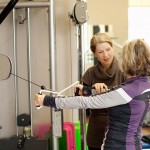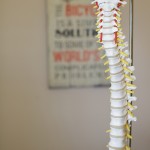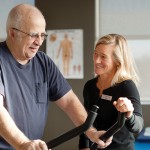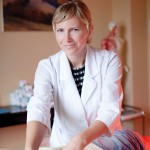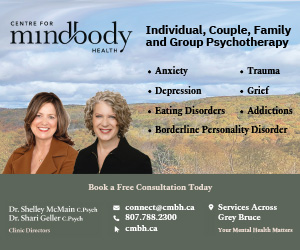Healthy joints for an active lifestyle
story by Marc Huminilowycz ❧ photography by Kristie & Brenden Woods
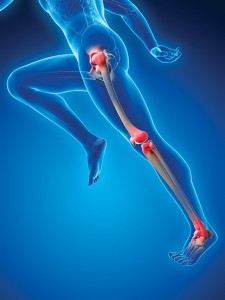
We who live and work in Southern Georgian Bay are an active bunch. With so many year-round recreational options available to us, our world is our oyster – but only if our bodies are up to it. As we age, the wear and tear of our earlier years can cause arthritis to develop in our joints, limiting our physical activities. Fortunately, our region has an abundance of excellent healthcare professionals and treatment options ready to help us continue enjoying the activities we love.
When you’re speeding down a mountain on skis at 120 kph, anything can happen – and often does. At the age of 18, former “Crazy Canuck” Todd Brooker, now a successful Southern Georgian Bay real estate agent and TV ski racing commentator, crashed while training for a World Cup ski race in Austria, tearing all four ligaments in his knee.
Despite the severity of his injury, a multitude of knee surgeries and hours of rehabilitation, Brooker managed to remain competitive in ski racing, earning three World Cup victories, seven podiums and 15 top-10 World Cup finishes, and ninth place at the 1984 Olympics in Sarajevo.
Then, at age 27, Brooker’s racing career came to an abrupt end in Kitzbühel, Austria, with one of the most spectacular crashes ever witnessed in competitive skiing. In the ensuing years, his knee deteriorated, causing constant pain with any activity. Brooker decided to see a sports injury physician, who described his condition as “post-traumatic osteoarthritis.” His original injury had damaged not only his ligaments, but also the cartilage in his knee. Over the years, the cartilage wore prematurely.
In addition to taking prescription arthritis medication, Brooker’s physician encouraged non-load-bearing exercises in order to maintain his knee flexibility, range of motion and strength. He also recommended “high tibial osteonomy” (HTO) surgery to straighten out Brooker’s bowed leg by transferring his weight to the outside half of his knee, where he still had cartilage. Brooker had the surgery in 2007.
“I was pretty sedentary around the time of my surgery, weighing about 230 pounds,” Brooker recalls. “My doctor was telling me to exercise but, because of all the weight I was carrying, moving my body was difficult and very painful.” Brooker decided he needed to lose weight in order to ease the load on his arthritic knee. Researching volumes of information on osteoarthritis, he discovered that a gluten-free diet – no wheat, no carbohydrates – could help him lose pounds and reduce inflammation in the knee joint (arthritis literally means “joint inflammation”).
Adhering to a regimen of gluten-free eating and regular non-load-bearing exercise, Brooker has lost 40 pounds since his HTO surgery. “These days, no matter how I move – whether it’s cycling, skiing, riding my horse or walking my dog – my knee always feels better after the activity than it did before,” he says. Brooker attributes his ability to stay active and relatively pain free to a combination of medication, diet and regular exercise.
Brooker’s experience is perhaps an extreme example of the effects of arthritis, which affects 4.6 million (one in six) Canadians. By 2036, that number is expected to increase to 7.5 million Canadian adults (one in five). According to the Arthritis Society, the disease encompasses more than one hundred conditions – ranging from mild tendonitis and bursitis to its most common form, osteoarthritis, to “systemic” (inflammatory) forms such as rheumatoid arthritis. Arthritis can strike anyone at anytime, regardless of age, physical condition or ethnic background, often with devastating and debilitating effects. The main symptoms of arthritis are chronic joint pain, stiffness and swelling, which can result in significant disability and poor quality of life.
Rheumatoid arthritis (RA) is a serious and debilitating disease that can affect people of any age. Although its cause is still unknown, RA is believed to be the result of a malfunctioning immune system, which attacks multiple joints in the body. Many of the practitioners and techniques covered in this article can help RA patients with pain relief and mobility, but any course of treatment should begin with the family doctor. While RA is a severe illness that requires medical intervention, this article will focus on osteoarthritis, the most common form of arthritis affecting residents in Southern Georgian Bay.
Sport Medicine
Until his recent retirement, physician Dr. John Bowman of Collingwood Sport Medicine and Rehabilitation Centre treated many patients with osteoarthritis for over 15 years. He says arthritis has been prevalent throughout history, but is more topical these days because, while people are aging, they are more active than previous generations.
From his experience, Bowman has several observations on osteoarthritis: under age 55, it affects men and women equally; over 55, it is more common in women (possibly due to the onset of menopause and a decrease in estrogen); almost everyone experiences some arthritis symptoms by the time they reach the age of 70; the disease occurs most often in the knees, hips and spine (less common in the feet and ankles).
What is osteoarthritis? Simply put, it is a condition where cartilage, the protective layer covering the ends of bones where they meet a joint, are damaged. “The joints in our bodies are coated with a substance similar to plastic,’” Bowman explains. “If cartilage wears out, you get bone-on-bone friction, which triggers an inflammatory reaction, sending irritants to the joint. The body then responds by making the joint painful.” Unfortunately, once cartilage wears out, it does not re-grow.
The causes of osteoarthritis are not totally clear. It can result from a genetic predisposition or in consequence of a number of factors: being overweight; previous joint injuries such as fractures and torn ligaments; activities with excessive knee load (such as kneeling, squatting, lifting or climbing); repetitive load activity (such as running); or sports injuries that twist or have a direct impact on a joint.
Bowman likens a person with osteoarthritis to “an old pickup truck with parts wearing out – you don’t want to overload it or drive it on bumpy roads.” This simple analogy is key to treating osteoarthritis, he says. “We very much want people to continue their activities, but it has to be done in a way that doesn’t do any harm. It all comes down to a modification of activities.”
Under new ownership, the Collingwood Sport Medicine and Rehabilitation Centre continues to help people with osteoarthritis using a multi-disciplinary team approach including sport medicine, physiotherapy, acupuncture and other therapies. “The key to treating the disease is diagnosis,” says senior physiotherapist and co-director Julie Moss-Kujala. “It begins with an assessment by a physiotherapist or a sport medicine physician.”
Moss-Kujala believes education is an important component of osteoarthritis treatment. The clinic’s main focus is on weight management through diet, and exercise to lighten the load on weight-bearing joints (hips, knees and feet).
“First we ask our clients which activities they enjoy doing,” she says. “Then we recommend minor modifications that will allow them to remain active with the least impact on their arthritic joints, while strengthening the muscles around those joints.”
To treat the primary symptoms of osteoarthritis, namely swelling, inflammation, pain and reduced mobility, the clinic employs a number of therapies that are tailored to individual patients’ condition and lifestyle. Physiotherapy techniques help to loosen tight tissue and restore motion, flexibility and strength. Acupuncture helps to relieve pain and swelling. Cold laser therapy increases the metabolism in cells, flushing out inflammation and increasing circulation. Ultrasound stimulates arthritic tissue, helping to improve blood flow.
Under the supervision of its two sport medicine physicians, the clinic also prescribes medication to reduce pain and inflammation, and uses several leading-edge therapies injected directly in the arthritic joint to help reduce symptoms. Cortisone, a potent anti-inflammatory used in conjunction with other arthritis therapies, acts as a ‘fire extinguisher,’ relieving symptoms temporarily to enable increased activity or exercise.
Platelet Rich Plasma (PRP), derived from the patient’s own blood, contains a high level of growth factors to help rebuild damaged tendons or cartilage. Used by the clinic primarily in the knee, early studies have shown favourable results in the relief of symptoms. For advanced osteoarthritis cases and comfort, the clinic can also custom fit patients with supportive devices such as an uploader brace, designed to take the load off worn joint surfaces.
While area sport medicine clinics offer a number of modalities to treat osteoarthritis, other healthcare professionals in the region also offer beneficial therapies, conventional and otherwise, for the disease. On The Bay interviewed several practitioners, representing a variety of disciplines, to learn how they are helping people to stay active in spite of their condition.
Physiotherapy
Physiotherapist Sue Underhill of Maximum Physiotherapy in Collingwood believes that osteoarthritis is very prevalent in our region, which has a large population of older athletes and people who “want to keep doing what they’re doing.” Working with her patients on range of motion, flexibility and strength, she advises caution with impact activities such as running, jumping or skipping.
“Osteoarthritis doesn’t mean stopping activity,” says Underhill. “It’s all about maintaining what you have and preventing the condition from getting worse by finding activities and exercises that are appropriate.” Following an assessment of the patient’s condition, she teaches exercises and techniques at her clinic that patients can continue at home, which can be as simple as actively extending the knee or riding on an exercise bicycle to improve range of motion.
“Every person is different,” she adds. “We recommend exercises that are geared to the patient, based on their specific complaint and goals.” Noting that arthritis in the knee is most common among her patients, Underhill advises those who are having trouble with normal everyday activities to be fitted with an uploader brace, to take the load off the affected knee.
Acupuncture
This discipline has been around for thousands of years, and continues to be widely accepted around the world as an effective tool for managing pain and inflammation. Corinna McFarlane of Blue Mountain Acupuncture in Collingwood emphasizes that acupuncture is an integral part of traditional Chinese medicine, which she formally studied prior to opening her practice.
According to McFarlane, acupuncture needles are a primary tool for treating osteoarthritis. “Eighty-five per cent of my practice is geared to treating joint issues – in knees, hips and hands, as well as degenerative disc disease, for which I have had great results,” she says. McFarlane treats people of all ages, from juveniles to patients well into their 80s, who often arrive using a cane or a walker. She works with almost 20 physicians in Barrie and Southern Georgian Bay, who refer patients with arthritic conditions.
Describing acupuncture as “treating the root and the branch,” McFarlane explains how the treatment works. “Acupuncture stimulates nerves in muscles and other tissues, leading to the release of endorphins and other body chemicals, which breaks the cycle of pain in the brain,” she says. “It also inhibits the activity of cytokines, which are mediators of inflammation, increasing microcirculation and helping to disperse swelling.”
McFarlane stresses the importance of breaking the cycle of pain from arthritis, so that patients can remain active. “Acupuncture is a tool for doing this, giving you a window of opportunity to stay active or return to activity,” she says.
Chiropractic
As with other disciplines, the majority of patients chiropractor Adam Markew treats at Georgian Family Chiropractic in Wasaga Beach are active adults. Focusing on the back, chiropractic treatments minimize stresses on joints and correct the mechanics of the spine, helping with mobility and pain.
“Back problems like degenerative disc disease tend to cascade out of control,” says Markew. “Chiropractic interrupts the cycle of wear and tear and corrects bad joint mechanics.” Assessing the patient – and requesting x-rays in extreme cases – Markew employs five primary chiropractic techniques, as required, to help with pain and mobility: activators, traction, drop table, muscle techniques or acupuncture.
“Dealing with osteoarthritis is a process,” Markew says, adding that his work on the spine often helps arthritic hips. “It takes a long time to get the disease, and it’s a long process to correct it. Deterioration is inevitable; what’s done is done. I help people to stop the progress of arthritis and move on.” His advice for avoiding or delaying osteoarthritis is simple: “Keep your body nimble and mobile. Be proactive to avoid the condition in the first place.”
Naturopathy
Bayside Wellness in Collingwood offers a multi-disciplinary approach to health care. On staff are two chiropractors, three massage therapists, a psychotherapist and a naturopath, Aranka Jones.
Jones, who also collaborates with a personal trainer at the Northwood Club, believes that poor dietary habits are a primary cause of osteoarthritis. “Processed foods, refined sugars and unhealthy fats increase weight and the amount of inflammation in the body, affecting joints and cardiovascular health,” she maintains.
Concurring with Todd Brooker, Jones singles out gluten, a “super carbohydrate” found in wheat, as a primary culprit in increasing inflammation. “Most people eat too many carbohydrates. High carb intake makes you crave more carbs throughout the day, which perpetuates a cycle of your blood sugar being out of balance,” she explains.
According to Jones, naturopathy is about detective work, getting to the root of what is causing the patient’s body to be out of balance. She starts by asking her patients questions about their diet. “There is a popular misconception about having to drastically change your diet when you see a naturopath,” Jones says. “The key is to make small tweaks to your diet and eat meals in balance. Start with a balanced breakfast including protein and healthy fats. Add healthier foods to your lunch and dinner. Just one small change can make you feel much better. You’ll have more control of your appetite, improve your mood and have more energy.”
Jones’ primary approach to treating osteoarthritis in her patients is teaching them how to control their weight through proper diet combined with low-impact exercise. She also recommends Omega 3 fatty acids (a natural anti-inflammatory) to balance out Omega 6 fatty acids found in processed foods.
For patients with advanced arthritis, Jones highly recommends taking a curcumin supplement. Describing curcumin, an extract of turmeric (found in curry powder), as “one of the most potent natural anti-inflammatory substances available,” she says her arthritis patients have experienced very positive results in managing their pain by taking the supplement.
Chiropody
According to chiropodist Tony Abbott of Abbott Foot and Ankle Clinic in Collingwood, the source of many arthritic conditions from the hips down can be attributed to problems with the foot – or the big toe, to be exact.
Abbot explains: “Mechanical forces cause the toe to dislodge. Over time, the cartilage wears out, causing spurs and deterioration around the toe joint. Because it is painful to walk normally, the body shifts, affecting the alignment of the knees and hips above, which can cause arthritis to develop in these joints as well.”
Abbott’s clinic offers four primary treatments for the misalignment of the big toe, a condition commonly known as a bunion: proper footwear made of softer material, wider in the front with a rocker sole, takes some of the stress off the toe; custom orthotics control abnormal forces on the feet; laser therapy stimulates healing deep within the tissues by removing “waste products”; and topical creams such as Cryoderm (Abbott’s favourite) help to reduce pain.
Massage Therapy
Christina Knott, registered massage therapist (RMT) at No More Knotts Massage Therapy Clinic in Thornbury says her osteoarthritis treatment aims to increase joint mobility and range of motion while decreasing stiffness and pain.
“We focus on strengthening the body from the inside out and teaching people how to move pain-free,” says Knott. “In addition to educating our patients on how to reduce daily wear and tear on their joints and improve their motion, I recommend easy, enjoyable exercises that aren’t strenuous or intense, such as pendulum swings and other range of motion exercises.”
As to actual manipulation of the arthritic joint, Knott is allowed up to ‘grade four’ joint mobilization as an RMT (compared to grade five for a chiropractor). Her technique opens up the arthritic joint to replenish “synovial fluid” and nutrients, thereby lubricating the affected area. “Like putting oil into the engine,” she explains.
Knott also works with her clients to strenghten the small muscles that support the joint. As long as the joint is not inflamed, she uses heat as a modality to increase blood circulation and reduce pain.
Osteopathy
Founded in 1874 by an American doctor, this profession embraces the notion that the body is naturally able to heal itself. Using a technique known as “palpation” (or “listening”) to sense the state of tissues and systems, the osteopathic practitioner focuses gentle touch to help unblock and restore the circulation of body fluids (such as blood, lymph, synovial and digestive), thereby enhancing the body’s natural ability to self-regulate and self-heal.
Brock Tadashore, an osteopathic manual practitioner, recently joined the Marsden Wellness Centre in Collingwood. He believes that his profession has much to offer in the treatment of osteoarthritis. “My goal is to promote healing by increasing range of motion and increasing circulation,” he says. “A big part of my practice involves education, identifying why patients have arthritis, and which internal and external irritants and postural issues may be affecting them.”
Tadashore focuses on the arthritic joint, noting its “position, quality, mobility and vitality” as well as the muscles supporting the joint, to make sure that they are working properly. He also looks above and below the joint to “help restore biomechanics and proper weight bearing.” By touching the affected areas, he claims to increase circulation, thereby restoring mobility.
Given our active – but nonetheless aging – population in Southern Georgian Bay, we are fortunate to have an impressive variety of professionals, right in our own backyard, providing treatment options to relieve our aching joints and improve our mobility so that we can continue enjoying the activities we love.
Ranging from conventional to alternative, there is something for everyone. Physicians like Dr. John Bowman do not rule out the benefits of alternative therapies in the treatment of arthritis – as long as they do no harm and we inform our family doctors about any treatments that we may be considering.
Perhaps, as Todd Brooker discovered, the key to managing arthritis lies in researching and exploring our options, and going with what feels right. ❧







